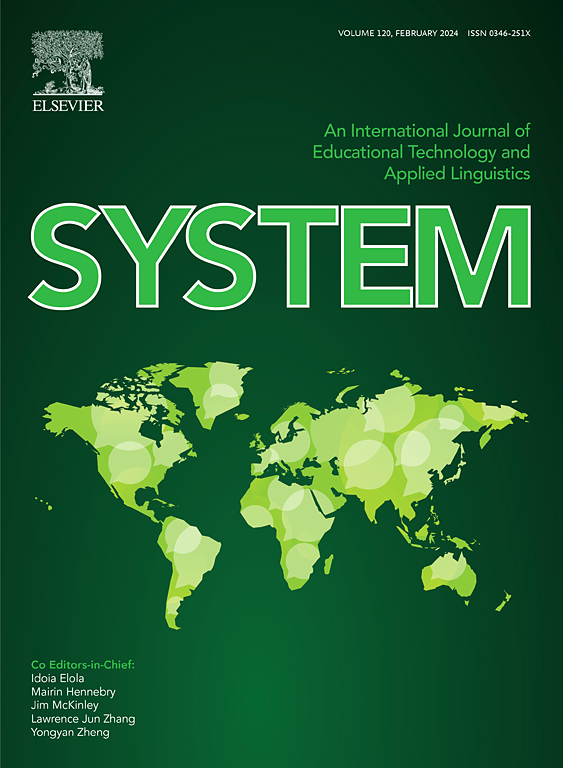自我效能感和英语水平背景下无聊感与英语成绩的关系研究:控制价值理论和岛岭曲线的结合视角
IF 5.6
1区 文学
Q1 EDUCATION & EDUCATIONAL RESEARCH
引用次数: 0
摘要
无聊被认为对第二语言/外语学习(L2)的成就有不利影响。关于无聊的研究通常是在控制-价值理论框架下进行的,认为控制(如自我效能和二语熟练程度)和价值(如重要性)的评价可以减少无聊及其对二语成就的影响。然而,这些联系大多被认为是线性的。岛脊曲线(IRC)理论认为个体属性与第二语言成就之间存在非线性关系。本研究结合控制价值理论和IRC,考察了自我效能感、无聊感、二语成就和二语熟练程度之间的非线性关系。共有400名来自中国某高中的10年级学生参与了这项研究。数据分析分为三个步骤:(1)进行潜在特征分析,识别潜在英语水平群体;(2)进行方差分析,比较不同熟练程度群体的无聊程度差异;(3)运用多群体结构方程模型,探讨无聊感、自我效能感与第二语言(英语)成绩在不同水平组间的关联变化。结果表明:(1)低、高二语水平组学生的无聊感表现较高(但差异不显著);(2)不同二语水平组学生的无聊感与英语成绩呈负相关,在负-零-负模式下波动;(3)自我效能感与无聊感呈负相关,在负(不显著)-大负-小负模式下波动。结果表明,控制值理论与IRC相结合对无聊感研究具有一定的价值。本文章由计算机程序翻译,如有差异,请以英文原文为准。
Examining the association between boredom and English achievement in the contexts of self-efficacy and English proficiency levels: A perspective combining the control-value theory and the Island Ridge Curve
Boredom is believed to have a detrimental effect on second/foreign language learning (L2) achievement. Studies on boredom are usually framed under the control-value theory, believing that appraisals of control (e.g., self-efficacy and L2 proficiency) and value (i.e., importance) can diminish boredom and its effect on L2 achievement. However, the associations are mostly assumed to be linear. The Island Ridge Curve (IRC) theory posits nonlinearity between individual attributes and L2 achievement. Combining the control-value theory and the IRC, the current study examined this nonlinearity in the relationship among self-efficacy, boredom, L2 achievement, and L2 proficiency. A total of 400 10th graders from a Chinese high school participated in the study. Data analysis involved three steps: (1) conducting latent profile analysis to identify the latent English proficiency groups; (2) conducting analysis of variance to compare the difference in the level of boredom across different proficiency groups; and (3) conducting multigroup structural equation modeling to explore the variation of the associations among boredom, self-efficacy, and L2 (English) achievement across different proficiency groups. Our results showed that (1) boredom appeared to be higher (though the difference is non-significant) with students in low and high L2 proficiency groups, (2) the association between boredom and English achievement was negative and fluctuated in the negative-null-negative pattern across different proficiency groups, and (3) the association between self-efficacy and boredom was negative and fluctuated in the negative (non-significant)-larger negative-smaller negative pattern. Our results show the value of combining the control-value theory and the IRC to study boredom.
求助全文
通过发布文献求助,成功后即可免费获取论文全文。
去求助
来源期刊

System
Multiple-
CiteScore
8.80
自引率
8.30%
发文量
202
审稿时长
64 days
期刊介绍:
This international journal is devoted to the applications of educational technology and applied linguistics to problems of foreign language teaching and learning. Attention is paid to all languages and to problems associated with the study and teaching of English as a second or foreign language. The journal serves as a vehicle of expression for colleagues in developing countries. System prefers its contributors to provide articles which have a sound theoretical base with a visible practical application which can be generalized. The review section may take up works of a more theoretical nature to broaden the background.
 求助内容:
求助内容: 应助结果提醒方式:
应助结果提醒方式:


